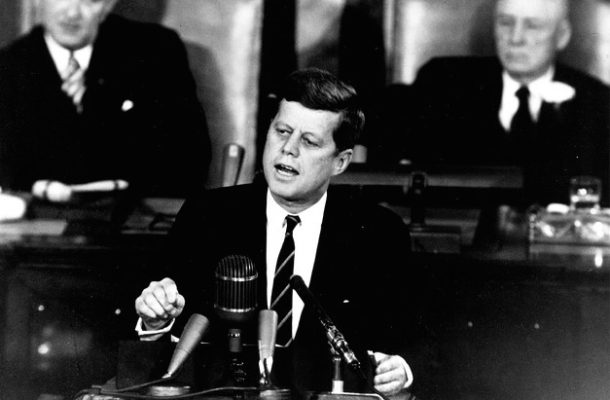When Conspiracies Meet: Donald Trump and the JFK Files

It seems the perfect recipe, a union of minds and fates. A case, long disputed, deliberated over, conspired over, meets a modern US president who favours the notion of birther theories, rigged systems, corrupt elites and corrosive establishments. As President Donald Trump announced over the weekend, “Subject to the receipt of further information, I will be allowing, as President, the long blocked and classified JFK FILES to be opened.”
Having himself been seen as a conspiracy theorist with some clout, Trump fittingly finds himself releasing files that are supposedly meant to shed light on the period in US history known as Camelot, along with its rude and violent conclusion with the slaying of President John F. Kennedy on November 22, 1963.
Trump has himself been, as he continues to be, an inspiration for the conspiracy aficionados. These tend to come in all political shades in a country where the paranoid strain, as Richard Hofstadter identified with forensic accuracy, nags and convinces.[1]
Be it Senator McCarthy’s claim in June 1951 of communist infiltration on vast scale; the assertion by leaders of the Populist party in 1895 that treacherous “gold gamblers” had forged an impoverishing conspiracy in 1865-6; or the inroads of Papal influences in the White House in the 1850s – all have left their mark on the traumatised psyche of US political unease.
The current set of conspiracies regarding Trump is becoming bibliographic in nature. Is he brain damaged or permanently impaired, the basis to rationally explain his frequent lapses into infantile effusiveness and sporadic bullying? Is he really an out-of-the-closet Russian operative singing and swinging to the score sheet of the Kremlin and strong man figure Vladimir Putin?
One particularly enduring one, even if its legs seemed terribly wobbly, was the claim that he was Hillary Clinton’s true standard bearer, holding the false flag for the Clinton campaign even as he was debunking every campaign tactic in the electoral rule book. Once that particularly flag caught fire, there had to be other explanations: Trump as avenger, vengeful exterminator of the Democrats.
The central problem to the conspiracy advocate is a system of permanent and impervious irrefutability, fuelled by the smallest kernels of truth. Nothing presented is empirically credible to alter convinced minds. For Trump’s own view, the Zeitgeist of the moment is Fake News writ large, a point that is only laughable to a point.
Any cursory understanding of news gathering and dissemination entails an understanding of mechanisms of self-censorship, the restrained (or planted hysterical) voice, the fiction of objectivity. Fabrication is impossible to divorce from news cycles, however stable. Not all news is counterfeit, but much of it is distorted by the lenses of power, decision and editorial consideration.
All evidence obtained can only point to affirming the conspiracy, rather than challenging it. In this context, the view of John Maynard Keynes – that changing facts duly changes opinions – is not only ignored but deemed impossible.
The legend of Camelot has had a decidedly devastating effect on the sober appreciation of US government institutions. The Kennedys were the US variant of the Royal Family and even more to the point, seemed photogenic, intellectual, glamorous.
The Kennedy family was itself the architect behind the faux aristocratic fantasy, the fiction, if you like, of an administration awash with shiny competence and brain heavy awareness. In truth, it was essentially piloted by a medically challenged and heavily medicated figure who suffered, amongst other conditions, Addison’s disease.
President Kennedy’s rocky stewardship, as Robert Dallek notes in considerable detail, was marked by anti-anxiety agents, sleeping pill popping, stimulants, and pain killers. The public image of a formidable, robust Cold War warrior was itself an elaborate fantasy, padded by its own conspiracy of deception. As if realising the implications of his medical burrowing, Dallek had to reiterate the point that Kennedy was still functioning and capable and was at no risk at cocking up during the Cuban Missile Crisis in 1962.[2]
The Kennedy’s were successful enough, be it through their army of ideological acolytes and publicists (think of the unquestioning pen of Arthur Schlesinger, Jr.), to create the impression of knight-like purity, intellectual sagacity and calm. To kill, then, what is noble, became an essential American trope: JFK, Bobby Kennedy, Martin Luther King, Jr. Behind each had to be a gargantuan conspiracy, an establishment puppeteer.
The Kennedy files that are promised for release are hardly going to rock the boat, alter the world, or change a single mind. Historians will be able to bring out modestly updated versions of old texts; official accounts might be slightly adjusted on investigations, locations and suspects, but the conspiracy set is bound to stick with grim determination to ideas long formed and re-enforced by assumptions that refuse revision.
Dr. Binoy Kampmark was a Commonwealth Scholar at Selwyn College, Cambridge. He lectures at RMIT University, Melbourne. Email: bkampmark@gmail.com
















Max Thomas
October 29, 2017 at 10:53 am
It’s been too long since I’ve enjoyed reading a contribution by Binoy at Open Forum. The fear of nuclear annihilation during the ‘Cuba missile crisis’ had a lasting effect on those of us who were at a very impressionable age at the time. Just as we felt the winds of change beneath our tentatively spreading wings, there was a terrible moment when it looked as though the end would precede the beginning. Binoy’s piece takes the reader past inviting side-tracks and invites reflection on what might have been a misadventure along the path to the inevitable. I was reminded of Dietrich Bonhoeffer who said: ‘stupidity is a more dangerous enemy of the good than malice. Against stupidity we are defenseless; reasons fall on deaf ears; facts that contradict one’s prejudgement simply need not be believed.’